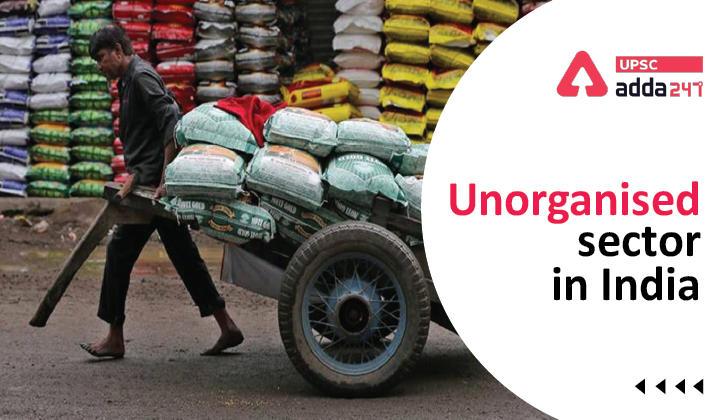Table of Contents
Unorganised Sector UPSC
- According to National Commission for Enterprises in the Unorganised Sector (NCEUS), unorganized sector consists of all the unincorporated private entities with less than 10 workers that engage in sale or production of goods and services.
- In India, around 80% of the labour force is employed in the informal/unorganised sector, and around 50% of the GDP is contributed by this sector.
Features of unorganised sector
- Low organizational level: Low in size, usually less than 10 employees, and mostly from the immediate family.
- Heterogeneity in functions;
- Entry and exit easier than formal sector;
- Limited capital investment;
- Often labour-intensive jobs, requiring low-level skills; as workers learn on the job, there is generally no formal training;
- Labour agreements focusses more on casual work and/or social relationships as opposed to formal contracts; sometimes, the relationship between employer and employee is unwritten and informal with little or no rights.
Unorganised sector issues
- Inadequate safety and health standards: Most industries, especially mining, have inadequate safety and health standards. Environmental hazards are common in the case of informal sector.
- Irregularities in Minimum Wages: Most of the studies that have examined the wage levels and earnings of workers have identified that the daily wages are below the minimum rate of wages.
- Long Hours of work: long hours work in the unorganised sector that is beyond the labour and regulatory norms are common in India.
- Poverty and Indebtedness: Workers in the unorganised sector have much higher incidence of poverty than their counterparts in the organised sector.
- Non-Applicability of Social Security Measures: There are times when a worker cannot be economically active. For instance, due to sickness or old age etc. There are hardly any social security measures for the unorganised sector workers to provide them risks coverage and ensure maintenance of basic living standards at times of crises such as unemployment or health issues.
- Lack of Proper Physical Environment: Lack of sanitation facilities impacts the health of the workers. The facilities such as washing, urinal and toilet facilities at work are found to be low standard.
Unorganised sector in India: Government steps
- National Commission for Enterprises in the Unorganised Sector: India is one of the pioneer countries to set up a commission named National Commission for Enterprises in the Unorganised Sector (NCEUS) in 2004 to study the problems and challenges that are faced by the informal economy.
- Poverty related development schemes: Several schemes have been initiated for poverty alleviation like the Nehru Rozgar Yojana, MGNREGA and the Swarna Jayanti Shahari Rozgar Yojana.
- Social security: To provide social security benefits, the Parliament enacted the Unorganised Workers’ Social Security Act, 2008. Schemes like Atal Pension Yojana, Pradhan Mantri Suraksha Bima Yojana, PM- Shram Yogi Man-Dhan Yojana, PM-SVANIDHI yojana, have also been launched.
- Skill development: To enhance the skill, the government has started various programs such as the Skill India Mission, Pradhan Mantri Kaushal Vikas Yojana, Deen Dayal Upadhyay Grameen Kaushal Yojana, recognition of prior learning etc.
- Insurance scheme: Life and disability cover is provided through Pradhan Mantri Jeevan Jyoti Yojana (PMJJBY) and Pradhan Mantri Suraksha Bima Yojana (PMSBY).
- Formalising the economy: Steps like GST, digitisation are steps towards formalising the economy.
Unorganised sector: Steps needed
- Overhauling labour laws: Labour laws, as well as tax policies, are key to improving the business environment. Labour regulations have to allow for more flexible work arrangements.
- Preventing occupational hazards: Steps should be taken to prevent occupational accidents and diseases by making policies through cost-effective and sustainable measures at the work-site level.
- Local support: Local institutional support should be built to progressively extend social protection.
- Sensitization: Special attention should be paid to the sensitization of policy makers, municipal authorities and labour inspection services to change their traditional role towards a preventive and promotional approach.
- Health protection: The extension of occupational health care to workers in the informal sector should be promoted. Also, a link should be established between first aid and prevention at the work-site’s level.
Read UPSC favourite topics





 TSPSC Group 1 Question Paper 2024, Downl...
TSPSC Group 1 Question Paper 2024, Downl...
 TSPSC Group 1 Answer key 2024 Out, Downl...
TSPSC Group 1 Answer key 2024 Out, Downl...
 UPSC Prelims 2024 Question Paper, Downlo...
UPSC Prelims 2024 Question Paper, Downlo...
